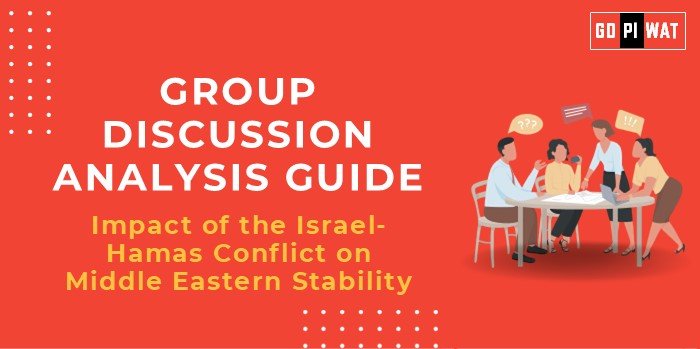📋 Group Discussion Analysis Guide: Impact of the Israel-Hamas Conflict on Middle Eastern Stability
🌐 Introduction to the Israel-Hamas Conflict
📖 Opening Context
The Israel-Hamas conflict has emerged as one of the most influential conflicts in recent Middle Eastern history, directly impacting regional stability and drawing global attention. Its relevance extends to international relations, humanitarian concerns, and economic implications.
📚 Topic Background
This conflict stems from historical tensions and territorial disputes, with recent escalations sparking widespread humanitarian, political, and economic challenges. As violence has intensified, so has the need for sustainable solutions to maintain regional stability.
📊 Quick Facts and Key Statistics
🏠 Displacement: Approximately 1.9 million people, or 90% of the population in Gaza, have been internally displaced, with many displaced multiple times.
🏚️ Infrastructure Damage: Over 215,000 housing units in Gaza are either damaged or destroyed, accounting for two-thirds of the region’s structures.
💵 Economic Impact: The conflict has caused approximately $18.5 billion in damages, nearly equal to Gaza’s highest-ever GDP ($19.17 billion in 2022).
🌍 Regional Tensions: The conflict has escalated military activities in neighboring countries like Lebanon and Syria, increasing the risk of broader hostilities.
👥 Stakeholders and Their Roles
- 🇮🇱 Israel and Palestine: The main parties, involved in territorial disputes and ideological differences, each seeking regional control and national security.
- 🌍 Neighboring Nations (Egypt, Jordan, Lebanon): Directly affected by refugee flows, economic impacts, and security concerns, often acting as mediators.
- 🏢 International Organizations (UN, Arab League): Provide humanitarian aid and facilitate peace efforts.
- 💼 Global Powers (USA, EU, Iran): Support peace initiatives, aid, or have political interests that shape policies, military assistance, and sanctions.
- 🧍 Local Citizens and Refugees: Bear the brunt of the conflict through displacement, loss, and economic instability.
🏆 Achievements and Challenges
✨ Achievements
- 🕊️ Diplomatic Initiatives: UN and international stakeholders have arranged temporary ceasefires to reduce conflict intensity.
- 🩺 Humanitarian Aid: Global organizations provide essential supplies and services to affected communities, particularly in Gaza.
- 📜 Peace Efforts: Historical frameworks like the Oslo Accords demonstrate structured attempts to address underlying issues.
⚠️ Challenges
- 🛑 Ideological Divide: Deep-rooted ideologies make it difficult for each side to compromise on key issues.
- ⚠️ Severe Humanitarian Crisis: Displacement, food insecurity, and lack of essential services strain the well-being of the Palestinian population.
- 🌍 Regional Instability: Escalations affect neighboring countries, creating diplomatic strains and security challenges.
🌐 Global Comparisons
- 🇮🇪 Northern Ireland Peace Process: Offers insights into resolving protracted conflicts with deep historical grievances.
- 🇷🇼 Rwanda’s Reconciliation: Demonstrates how former adversaries can build a future with structured reconciliation programs.
💡 Structured Arguments for Discussion
Supporting Stance: “International diplomatic intervention is critical, as the conflict influences broader regional security and economic stability.”
Opposing Stance: “Peace initiatives will continue to face setbacks until both parties can negotiate on core issues such as land and sovereignty.”
Balanced Perspective: “Temporary ceasefires highlight a capacity for reduced tensions, but sustained peace requires addressing long-term ideological, territorial, and humanitarian concerns.”
🗣️ Effective Discussion Approaches
- 📊 Opening Approaches:
- 🛑 Current Crisis Emphasis: “The Israel-Hamas conflict has led to nearly 45,000 casualties, highlighting the pressing need for a peace-building approach.”
- 📜 Historical Context: “Decades of territorial and ideological disputes have led to significant instability in the region, with the Israel-Hamas conflict at the center.”
- ⚡ Counter-Argument Handling: Acknowledge the limited success of past peace processes but emphasize the importance of renewed, innovative diplomatic efforts supported by data and case studies.
📈 Strategic Analysis of Strengths and Weaknesses
- 💪 Strengths: Diplomatic support from international organizations; humanitarian aid and support for affected communities.
- 🔧 Weaknesses: Entrenched ideological barriers obstructing sustainable peace; severe economic and infrastructural damages in Gaza.
- 🚀 Opportunities: Regional collaboration for humanitarian assistance; diplomatic peace efforts involving local stakeholders.
- ⚠️ Threats: Risk of conflict spillover into nearby nations; potential exploitation of the crisis by extremist factions.
🎓 Connecting with B-School Applications
- 💼 Real-World Applications: Relevant for understanding international relations, humanitarian challenges, and geopolitical strategies.
- ❓ Sample Interview Questions:
- “What is the role of international organizations in managing conflicts like Israel-Hamas?”
- “How does the Israel-Hamas conflict impact the broader Middle Eastern economy?”
- 🧠 Insights for B-School Students: Provides a view of conflict management, diplomacy, and the impact of regional instability on global economies.


